By focusing on individual electricity issues and addressing them with Advanced Distribution Management, utilities can help their communities advance incrementally toward grid modernization.
The U.S. is experiencing a period of reflection and re-evaluation in our evolution to the smart grid.
Think back to the projections of 2005. Most utilities planning to launch smart grid projects saw smart metering and new residential pricing options as a necessary first step. Analysts anticipated a year or two of utility pilot programs, rapid deployment of smart meters – perhaps an 89 percent market penetration in North American by 20121 – and a continent-wide roll-out of residential and commercial dynamic pricing programs for electricity.
That is not, of course, what happened. Today, most utilities either have not started or are still in the pilot stage of smart metering programs. The number of pricing programs reliant on smart meters is growing very modestly, according to the Federal Energy Regulatory Commission (FERC); in the case of time-of-use pricing, program numbers are actually expected to decline.2
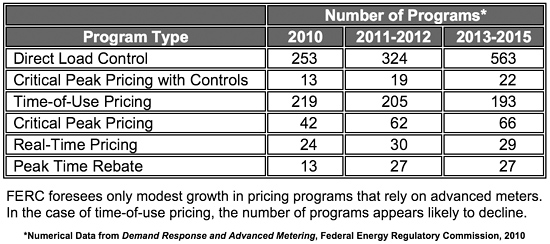
Similarly, smart meter penetration has been slower than projected. By the end of 2010, fewer than 9 percent of U.S. customers had smart meters. Projections for the end of 2012 hover between 25 and 38 percent – and even that may prove to be too high.
A Standard Stop on the Road to Technology Adoption
Today’s reassessment of smart grid plans is only to be expected. Hesitation is a common characteristic of the way individuals and societies undertake almost any major change.
Initially there’s an inspiring idea, an outlined goal, a new product. Participants eagerly sign on. Then comes a period of pushback. Some see the goal or product as too costly. Others believe it will threaten specific groups or time-tested ways of doing things. Others just want to think more about the issue, take more time, and gather more facts.
Not all pushback is well founded. The charge that smart meters cause negative health effects, for instance, appears to be scientifically invalid. Frequently, however, those pushing back make points that resonate widely. The Governor of Illinois and the Maryland Public Service Commission are not the only smart grid stakeholders who see value in more review, more ratepayer protections, and more consumer involvement.
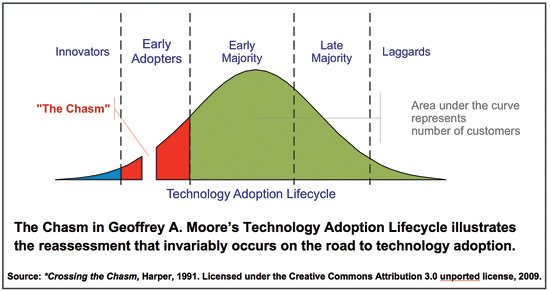
Bridging the Gap
This period of reassessment has become a standard feature of technology adoption. Even when we anticipate it, however, the gap in forward movement invariably feels like a setback to those who see the value of the goal. Fortunately, leaders can bridge what Geoffrey Moore refers to as “The Chasm” in technology adoption by listening to opponents’ arguments and modifying plans accordingly. That re-alignment in smart grid planning is now taking place at utilities across the country.
A first step in the reassessment of the smart grid evolution has been a change in rhetoric. To many, the term “smart grid” has come to connote a change that is occurring too rapidly and without enough thought. To alter perceptions, many utilities are replacing the goal-oriented “smart grid” phrase with terms that better connote thoughtful process, such as “grid modernization.”
A second step toward restarting the future has been to shelve rapid deployment of new consumer pricing programs. In 2005, rapid deployment appeared necessary as a way to cope with constantly rising electricity demand. But falling demand resulting from global recession has dramatically curtailed the need for dynamic pricing as a path to conservation. While no one would have wished for today’s faltering economic conditions, they have given both utilities and consumers the opportunity to step back from implementation of pricing proposals for which consumers were simply not prepared.
The Role of Advanced Distribution Management
A third step utilities are taking to bridge the grid modernization “chasm” is to broaden the scope of the project and to reorder the steps in the process. They no longer describe the goal as creating a platform for vaguely defined “new services” or “21st Century business processes.” Instead, they are increasingly defining modernization projects as a series of optional, independent steps, each focused on solving a definable problem, and each delivering tangible benefits.
Often, these projects resonate best with stakeholders when they focus on utility basics like improving reliability and efficiency. And the technology increasingly proposed to solve the problems is not the smart meter but instead new class of software known as Advanced Distribution Management (ADM).
The emergence of ADM represents a different approach to change – a commitment to phase and stage solutions to a near-term, definable set of grid objectives and customer benefits.
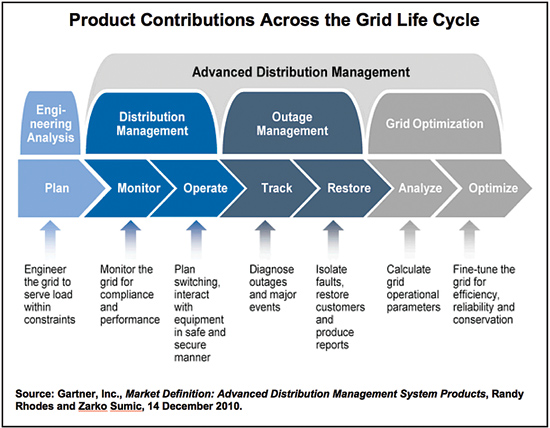
ADM is an umbrella name for a set of software systems that exercise full control over existing and new grid hardware – sensors, nodes, embedded devices, and advanced meters. Viewed as a whole, ADM:
- Increases “situational awareness” by providing a full 360-degree view of the grid for management, operations, crews, service representatives, and customers.
- Increases grid efficiency, reliability, and security.
- Defers the need for new grid construction by safely taking existing assets to their physical limits though improved monitoring and asset analytics.
- Responds to new customer technology challenges like electric vehicle adoption and efficient use of ‘beyond-the-meter’ customer generation from intermittent renewables (e.g., solar rooftops) – including operational and forecast modeling.
- Maximizes use of intermittent, renewable power produced both locally and remotely.
It is helpful, however, to view ADM not in the aggregate, but instead as a set of targeted solutions, including:
- Power flow and suggested switching objectives.
- Volt/Var optimization that will also leverage customer voltage violations from AMI investments.
- Feeder Load Management that not only forecasts when feeder capacity constraints could arise, but also suggests optimal switching plans to avoid it altogether.
- Incorporation of increasingly diverse supply (for instance, from intermittent renewables and small, distributed generation sources).
- Fault location, isolation, and service restoration (FLISR).
- Conservation voltage reduction (CVR).
- State estimation.
- Support for reducing peak demand and recharging electric vehicles.
Distributed grid management through microgrids that:
- Support distributed generation and distribution optimization in a remote environment.
- Operate under the overarching authority of a centralized ADM system, as required for safe and reliable operations.
These solutions – deployed individually or in groups of two or three – can solve a wide range of utility, customer, and community issues.
Issue: Expectations for Reliability are Changing
Solution: ADM’s Fault Location, Isolation, and Service Restoration (FLISR)
North American utilities’ reliability records are generally outstanding. But as utilities are beginning to discover – much to their chagrin – yesterday’s top SAIFI and CAIDI numbers may not satisfy today’s consumer.
The reason is change in lifestyle. Yesterday, “downtown” reliability during the workweek generally took priority over neighborhood or suburban reliability. Multiple alternative sources automatic fail-over switchgear kept office workers productively at their desks. Customers noticed short weekday neighborhood outages only when blinking clocks indicated that homes had lost electricity while they were gone.
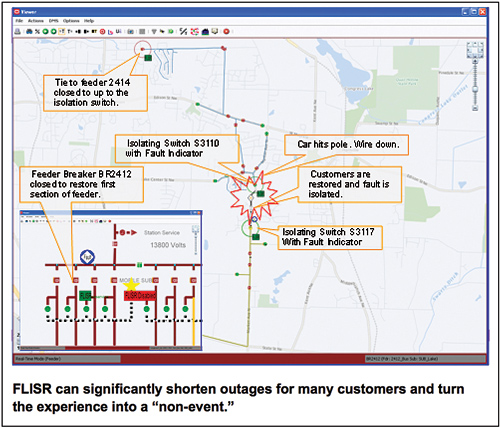
Today, increasing numbers of employees work full- or part-time from home. They notice short neighborhood outages because they suddenly lose use of their computer peripherals. Outage times that drop Internet connections and exceed laptop batteries lead to unhappy customers’ seeking the nearest operating Starbucks for power and Internet access relief.
At-home workers are not the only change among residential customers. Today’s communities are highly sensitive to tree trimming. Yesterday, complaints focused on aesthetics. Today, utilities face far stronger environmental attitudes and stringent local regulations aimed at preserving tree canopies.
ADM is one way to address expectations for higher levels of reliability despite restrictions on tree trimming. Fault location, isolation, and service restoration (FLISR) and Fault Location Analysis can turn outages into momentaries by isolating faults and pinpointing outage locations before crews arrive, identifying customers who can be served by still-operating lines, and reconfiguring the network to serve them while restoration proceeds.
Issue: Incorporate More Renewables
Solution: ADM’s Detailed Network Model
Despite recent reductions in electricity demand and the vast supply increase in more environmentally friendly natural gas, green mandates remain on the books in many states. And they are likely to remain there, challenging utilities to maximize their use of locally sourced renewables.
Today, the introduction of energy resources at the electric distribution level – for instance, power generated from solar rooftops – challenges many operational systems when they need to accept unconstrained levels of alternative energy resources. Today’s systems often lack the detailed models that can provide an accurate accounting of the energy injections and flow of power across the distribution network in addition to real-time, near-term forecasts that anchor a complete assessment of the nature of power delivery in the distribution network.
To integrate intermittent renewables successfully, network models must expand to include:
- Circuit models showing the distribution lines connected to source nodes, network equipment, grid devices, etc. These are usually derived from a GIS or other circuit mapping system source.
- Customer connectivity through secondary services or data linkage to service transformers.
- Conductor and cable type, including overhead line construction type and underground cable spacing to calculate engineering parameters such as line impedances and thermal loading limits that add unbalanced 3-phase impedance and capacity characteristics to the model. This operates the real-time unbalanced load-flow for system optimization.
- Engineering and forecasting models of customer loads, intermittent renewable resources, electricity storage, and their network connections to the dynamic models.
- Customer meters and beyond-the-meter resources (e.g., backup generation, electricity storage characteristics, electric vehicle charging profiles, demand response capability).
ADM solutions’ enhanced models proactively identify probable locations and durations of intermittent supply drops; then, identify alternate sources of supplies. If the need materializes, ADM solutions can orchestrate alternative generation, demand response options, and storage supplies to accommodate both short-and long-duration supply drops.
Once in place the detailed network models, vital to use of intermittent renewables can also underpin a wide variety of additional ADM solutions that increase grid efficiency, monitor and adjust voltage, and heighten service quality.
Issue: Recharge Electric Vehicles
Solution: ADM’s Microgrids
North America anticipates a slower adoption of electric vehicles (EVs) than do more densely populated countries in Europe and Asia. Per capita infrastructure costs, driving distances, and the availability of locally produced fossil fuels will likely retard EV growth in North America. Some utilities, however, will be challenged to make fast, off-peak refueling available in specific cities or specific neighborhoods where two-income households, private parking spaces, and environmental commitments produce concentrations of early EV adopters.
Handling this new demand will increase the need for ADM solutions. The same enhanced modeling required for handling of intermittent renewables will be a necessary component. So will equipment upgrades and control strategies that permit utilities to ensure that EVs are all appropriately recharged at some point during an overnight refueling cycle.
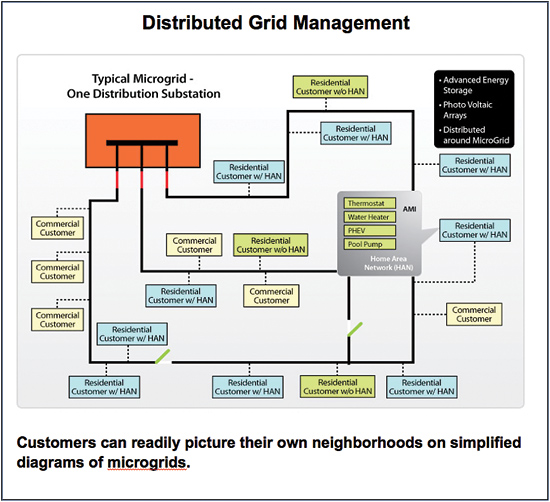
Additionally, distributed grid management and its associated microgrids can play a strong role. Microgrids solve one or a combination of problems that are difficult to handle on a large scale but manageable when confined to a small geographic area. They:
- Integrate power from small, distributed generation facilities, such as rooftop solar, into the grid. Today’s net-metered generation – frequently consisting of a few kilowatt hours delivered on an unpredictable schedule – is largely useless within the context of a large utility geared to handling megawatts of power for tens of thousands of customers simultaneously. Microgrid software, in contrast, can be fine-tuned to the potential production from local sources and supplemented with weather and other information that brings considerable predictability to “non-dispatchable” generation from variable renewables.
- Charge non-fleet electric vehicles. Today’s utility aims to accommodate, without brown- or blackouts, any amount of demand at any time. Using this model to accommodate electric vehicles would likely require a massive increase in infrastructure and generation. A microgrid, however, could use local, variable generation to charge vehicle batteries intermittently, as power was available. Such a model could, of course, be managed on a large, centralized basis, but it is likely to be far easier to delegate distributed control and optimization on a smaller scale.
- Incorporate electricity storage from batteries and other storage devices. Microgrids could use excess local generation to charge these resources in off-peak periods, where low-priced energy is readily available, and draw from them at peak-demand periods when power runs short, and spot prices are highest, thus limiting the amount of generation they require from central generators. Microgrids can manage storage (charge-discharge algorithms) in order to provide an energy arbitrage benefit that more than offsets the round-trip efficiency losses of the storage technology.
- Assure safety and reliability with the overarching authority of centralized ADM to provide real-time dispatcher interaction to the distributed microgrid processes. Presented as an abstract concept, microgrids frequently fail to garner consumer interest, much less support. Presented as an efficient recharging strategy in neighborhoods with large EV concentrations, they attract attention. And described in terms of values like independence, local control, and energy security, microgrids can become an exciting community project.
A Grid that Meets Customer Needs
Utilities well understand the need for an improved grid. But the concept has proven too large and abstract for many customers to swallow. And the decision to launch smart grid projects with advanced meters – a move many thought consumers would welcome – has instead created backlash.
As a result, an increasing number of utilities are starting grid modernization programs from the other end – by implementing advanced distribution network solutions that, in the aggregate, dramatically increase efficiency and prepare the grid for a resumed period of growth. Winning support for these ADM solutions may be faster when utilities portray the solutions – completely accurately – in terms of the customer and community issues they address rather than in the engineering terms most network operators find compelling.
ADM solutions can serve as a bridge between engineering reality and emerging customer needs. They can permit network engineers to respond clearly and directly to customer-generated requirements. They can help utilities place the investment and maintenance costs of meeting those requirements in the context of other utility business applications. Today, ADM solutions are helping to break down the walls between a utility’s operational and business departments, creating a utility increasingly fine-tuned to its customers.
About the Author
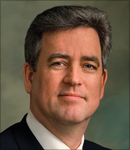 Rodger E. Smith is senior vice president and general manager for the Oracle Tax and Utilities Global Business Unit. In this position, he leads the global business unit’s solution groups, strategic planning, product development, sales, service, and support.
Rodger E. Smith is senior vice president and general manager for the Oracle Tax and Utilities Global Business Unit. In this position, he leads the global business unit’s solution groups, strategic planning, product development, sales, service, and support.
Mr. Smith is the former president of Enterprise Management Solutions (EMS), the management consulting division of Black & Veatch. In this position, he grew the division into one of the largest management consulting organizations specializing in energy and water. He previously held positions with PricewaterhouseCoopers and Southern Company, the latter one of the largest electric utilities in the United States.
1 Datamonitor, 2007. Reported at http://www.energybusinessreports.com/articles/view.asp?id=438 and elsewhere.
2 2010 Assessment of Demand Response and Advanced Metering, http://energy.gov/sites/prod/files/oeprod/DocumentsandMedia/FERC_Assessment_of_Demand_Response_and_Advance_Metering.pdf







